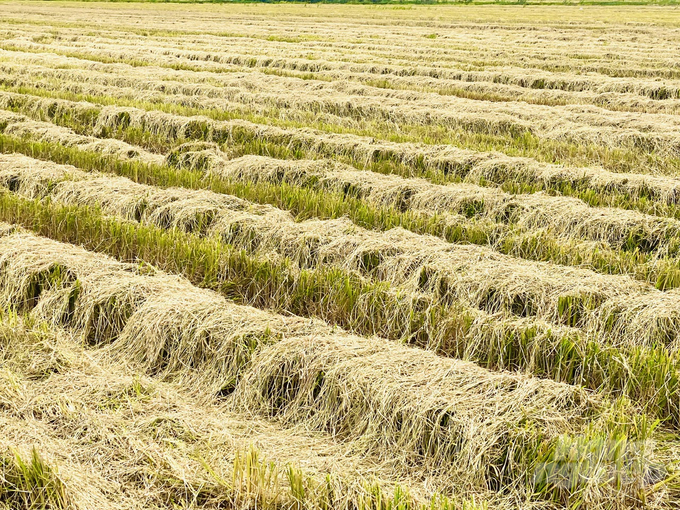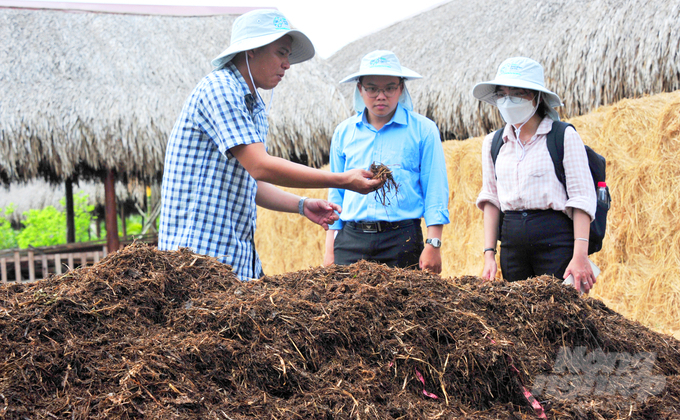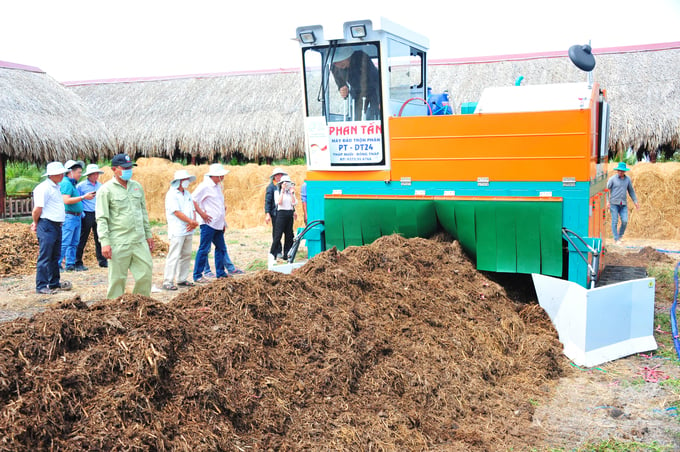June 2, 2025 | 07:55 GMT +7
June 2, 2025 | 07:55 GMT +7
Hotline: 0913.378.918
June 2, 2025 | 07:55 GMT +7
Hotline: 0913.378.918

Mekong Delta produces about 24 million tons of rice yearly, and the same straw is discarded into the fields. Photo: Le Hoang Vu.
Every year, the Mekong Delta produces about 24 million tons of rice, and tons of straw are discarded into the fields. Utilizing agricultural waste and by-products as organic fertilizer helps clean the environment, reduces pollution and emissions, creates jobs, increases income, and provides a source of organic fertilizer for the soil.
Mrs. Pham Thi Minh Hieu, Head of the Department of Crop Production and Plant Protection of Can Tho City, said that the high price of materials has put pressure on agricultural producers. Therefore, the agricultural sector of Can Tho City has cooperated with the International Rice Research Institute (IRRI), the Ho Chi Minh City University of Agriculture and Forestry (HCMUAF), and Tien Giang University to guide farmers to utilize straw instead of throwing it away, and compost it into organic fertilizer for crops, helping farmers reduce costs and increase profits.
According to Mrs. Hieu, recently, the agricultural sector of Can Tho City has implemented pilot models of rice cultivation using organic fertilizer from straw combined with technical advances "1 must 5 reductions" in Thoi Lai, Co Do and Thot Not districts... Through evaluation results, the model helps farmers reduce 35 - 40% of the cost of using fertilizers and chemicals and increase profits by 10% in the same area compared to traditional production.

Using agricultural waste and by-products as organic fertilizer helps clean the environment, reduce emissions, create jobs, and increase income for farmers. Photo: Le Hoang Vu.
According to Dr. Nguyen Van Hung, Head of the Mechanization and Post-Harvest Group - International Rice Research Institute (IRRI), the technology of producing organic fertilizer from straw helps ensure quality and is about 50% cheaper than fertilizers on the market. Organic fertilizers have the effect of improving the soil, improving the quality of agricultural products, and ensuring safety for consumers. A distinct advantage of this technology is the combination of mechanics (or physics) and biochemistry to optimize the effective decomposition of straw and organic quality. In addition to creating value for straw, using straw to compost organic fertilizer has reduced greenhouse gas emissions compared to burying straw after harvest. Moreover, avoiding burning straw in the field is one of the criteria for the set of standards for sustainable rice production, increasing income, and protecting the environment.

Through the evaluation results of many rice crops, farmers using organic fertilizers help reduce 35-40% of the cost of using fertilizers and chemicals and increase profits by 10% in the same area compared to traditional production. Photo: Le Hoang Vu.
Mr. Hung shared more about straw composting techniques: In the case of composting using straw and cow dung, the corresponding ratio between these two materials is 6/4, but it also depends on the moisture content of the materials. In practice, the compost bed can be added with soil (rich in N), and then the composition of the compost bed includes 60% straw, 30% cow dung, and 10% soil, which are calculated with the same moisture content. The size of the compost bed cross-section depends on the size and capacity of the mixer. For a combined mixer with a 30 - 35HP tractor, the cross-section of the compost bed has a bed foot width of 1.2m and a height of 0.7m.
For straw after mushroom cultivation (50 - 60%) and cow dung (60 - 70%), the corresponding mixing ratio is 1.2:1, with C/N = 26.1. In the case of using 14% dry straw and 30% dry cow manure, the corresponding ratio is 1:1. In the case of composting straw after mushroom cultivation with a humidity of 60–70% and 10% dry cow manure, the mixing ratio by mass is 5.6:1. The amount of probiotics is 5 liters, mixed with water and sprayed into the compost bed.
The straw material has a higher humidity than required, so no more water is added during the mixing process. For raw materials, dry straw and field soil have a ratio of 7:3, and the humidity is 30%, 0.5% URE, 1% P, 0.3% K, and 0.2% molasses. In addition, 1% liquid and 1% powdered probiotics are required.

After cooling, the finished product is ready for use after finishing organic fertilizer, after cooling, about 45 days after the first mixing. Photo: Le Hoang Vu.
After cooling, the finished product is ready for use after finishing organic fertilizer, after cooling, about 45 days after the first mixing. The product has a 30-40% moisture content, which can be classified through a large impurity sieve. The quality of finished organic fertilizer is evaluated through the indicators of C, N, P, and K components, C/N ratio, pH, and humidity. From the experimental results of many different raw materials, the C/N ratio of the finished product is 13-14.5, pH: 6.8-7.2, humidity 35-40%, then spread evenly indoors to reduce humidity to 30% before mixing as a substrate or sun-dried to 14% humidity before going through the pelletizing process.
In the coming time, it is necessary to recommend that people widely use organic fertilizer from post-harvest straws to reduce environmental pollution while taking advantage of and regenerating abundant organic resources, ensuring the trend of clean agricultural development and the demand for organic food.
Translated by Huong Giang

(VAN) Several scientists and farmers are experimenting with soil treatment in some key durian-growing regions such as Cai Lay (Tien Giang), Dak Song, Gia Nghia, and Dak R’lap (Dak Nong).
/2025/05/25/4127-3-073637_820.jpg)
(VAN) Thanks to the promotion from an FAO-implemented project, vegetable production in greenhouses in Moc Chau has seen strong development, from 1.5 hectares in 2021 to nearly 50 hectares in 2024.

(VAN) FAO has recently supported USD 140,000 to implement the project 'Risk mitigation human-animal interface risks through disease control initiatives in pig farming.'

(VAN) The People's Committee of Tra Vinh province has approved an adjustment to the investment policy for the Green Hydrogen Plant project, increasing its area to approximately 52.76 hectares.
![Reducing emissions from rice fields: [2] Farmers’ commitment to the soil](https://t.ex-cdn.com/nongnghiepmoitruong.vn/608w/files/news/2025/05/05/dsc08881jpg-nongnghiep-140632.jpg)
(VAN) Clean rice cultivation model in Thuong Tan commune, Bac Tan Uyen district, is assisting local residents in achieving sustainable agriculture by substantially reducing costs, increasing productivity, and protecting the environment.

(VAN) At the conference to disseminate Resolution No. 68, AgriS introduced its digital agricultural ecosystem and reaffirmed its commitment to accompanying the Government in promoting private sector development and sustainable agriculture.

(VAN) 'Blue Ocean - Blue Foods' initiative is designed to restore marine ecosystems and establish sustainable livelihoods for local communities by cultivating a minimum of 1,000 hectares of cottonii seaweed in the first three years.